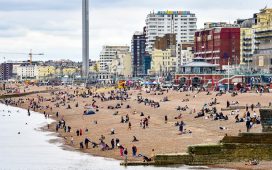Climate change has triggered a surge in increasingly frequent and intense heated episodes globally, raising a crucial question: how does extreme heat affect our daily routines, travel habits, and overall quality of life?
A new study sheds light on this pressing issue, offering valuable insights into how individuals and communities adapt to rising temperatures.
Heat’s impact on human behavior
A team of experts from Arizona State University (ASU), the University of Washington, and the University of Texas at Austin have collaborated on an insightful study.
The research sheds light on the compelling necessity for policy changes as urban areas worldwide scramble to deal with soaring temperatures.
“There is growing interest in understanding the interaction between weather and transportation and the ability of communities and the nation’s infrastructure to withstand extreme conditions and events,” noted the researchers.
“This study aims to provide detailed insights on how people adjust and change their activity-travel and time use behaviors in the face of extreme heat conditions.”
Daily influence of extreme heat
The scientists meticulously examined the influences of extreme heat on day-to-day activity and travel patterns, particularly among distinct socio-economic groups.
The research was based on data obtained from the American Time Use Survey (ATUS) and weather updates from the National Oceanic and Atmospheric Administration (NOAA).
The focus was on 11 major U.S. metropolises including Atlanta, Chicago, Dallas, Houston, Los Angeles, Miami, New York, Philadelphia, Phoenix, Seattle, and Washington, D.C.
Heatwaves disrupt ordinary routines
The study’s findings are striking. The results suggest that scorching temperatures significantly curtail the time people spend outside their homes.
Quite understandably, people prefer to remain indoors, reduce outdoor activities, and avoid non-essential travel during extremely hot days.
Data indicates a notable dip in journeys undertaken for leisure, shopping, and socializing when temperatures rise.
In addition, individuals tend to reschedule their trips to cooler times of the day, favoring early morning or late evening ventures to evade the midday heat.
Transportation preferences shift during heat
Extreme heat scenarios introduce a noticeable shift in transportation behaviors. The use of personal cars escalates, while walking, biking, and public transit usage takes a severe beating.
On average, the use of public transit plummets by almost 50% on sweltering days, as individuals seek solace in the comfort of air-conditioned private vehicles.
This shift poses substantial hurdles for cities striving to promote sustainable transportation modes, especially as weather extremes become more frequent.
The heat’s heaviest burden
The research further revealed that some groups bear the brunt of extreme heat more than others.
Low-income individuals and those without access to cars are forced to rely on walking or public transportation, thereby exposing them to perilous temperatures.
These individuals, facing the most rigid work schedules, often have no choice but to travel, even when temperatures are unbearable.
“We see that extreme heat exacerbates inequities in mobility and activity-travel participation,” said study lead author Ram M. Pendyala.
“Those who are already at a disadvantage, face even greater risks during heat waves. This is a clear call for targeted policy interventions to protect the most vulnerable population groups.”
Policy changes to beat the heat
Given these conclusions, the researchers have proposed a series of policy recommendations to alleviate the extreme heat impacts on communities.
These include introducing shaded public spaces, offering transportation vouchers for vulnerable populations, and proclaiming “heat days” akin to “snow days,” during which public movement is limited to protect health and safety.
Urban improvements such as planting more trees and using heat-reflective materials on pavements could also help make cities more heat-resilient.
Charges are needed for a hotter future
With the frequency and intensity of heatwaves projected to rise due to climate change, the study’s findings could not have come at a more critical time.
The research highlights the urgent need for cities to weave heat mitigation tactics into their transportation and urban planning initiatives.
The researchers hope their findings will prompt policymakers to take swift steps towards creating more heat-resilient cities.
“Our goal is to provide the evidence necessary to drive meaningful change,” said Pendyala.
The study is published in the journal Transportation Research Part D Transport and Environment.
—–
Like what you read? Subscribe to our newsletter for engaging articles, exclusive content, and the latest updates.
Check us out on EarthSnap, a free app brought to you by Eric Ralls and Earth.com.
—–







